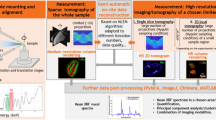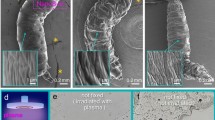Abstract
Three-dimensional micro-XRF is a recently developed microprobe which facilitates three-dimensional resolved chemical analyses with a resolution of around 20 μm. Arbitrary sites or sections of samples can be investigated without the need to section specimens physically. In this paper we demonstrate the use of the microprobe in combination with a cold nitrogen gas stream for the cryogenic fixation of specimens. A 3D micro-XRF setup at the new microfocus beamline at BESSY II was equipped with a nitrogen cryogenic stream. The distribution of Ca, Fe, Zn and Cu across virtual cross sections of a water-rich sample, the root of common duckweed, could be investigated without further sample preparation. This paper demonstrates the capabilities of 3D micro-XRF under cryogenic conditions for investigations of biological specimens.
Access this article
We’re sorry, something doesn't seem to be working properly.
Please try refreshing the page. If that doesn't work, please contact support so we can address the problem.








Similar content being viewed by others
References
Weseloh G, Staub S, Feuerborn J (2006) X-ray fluorescence analysis in the life sciences. In: Beckhoff B, Kanngießer B, Langhoff N, Wedell R, Wolff H (eds) Handbook of practical X-ray fluorescence analysis. Springer, Berlin Heidelberg New York
Kanngiesser B, Malzer W, Reiche I (2003) Nucl Instr And Meth B 211:259-264
Kanngießer B, Malzer W, Rodriguez AF, Reiche I (2005) Spectrochim Acta B 60:41-47
Bulska E, Wysocka IA, Wierzbicka MH, Proost K, Janssens K, Falkenberg G (2006) Anal Chem 78:7616–7624
Vincze L, Vekemans B, Brenker FE, Falkenberg G, Rickers K, Somogyi A, Kersten M, Adams F (2004) Anal Chem 76(22):6786–6791
Wang W (1990) Environ Res 59(1):7–22
Melaragno JE, Walsh MA (1976) Am J Bot 63(8):1145–1157
Erko A, Schäfers F, Firsov A, Peatman W, Eberhardt W, Signorato R (2004) Spectrochim Acta B 59:1543–1548
Malzer W, Kanngießer B (2005) Spectrochim Acta B 60:1334–1341
Smit Z, Janssens K, Proost K, Langus I (2004) Nucl Instrum Methods Phys Res B 219–220:35–40
Woll AR, Mass J, Bisulca C, Huang R, Bilderback DH, Gruner S, Gao N (2006) Appl Phys A 83(2):235–238
Acknowledgement
This work was partially funded by the Federal Ministry for Education and Research (BMBF) of Germany. We thank Udo Hesse for the photographs and Alexandra Graebert (HMI, Berlin) for her support in taking microscope images.
Author information
Authors and Affiliations
Corresponding author
Rights and permissions
About this article
Cite this article
Kanngießer, B., Malzer, W., Pagels, M. et al. Three-dimensional micro-XRF under cryogenic conditions: a pilot experiment for spatially resolved trace analysis in biological specimens. Anal Bioanal Chem 389, 1171–1176 (2007). https://doi.org/10.1007/s00216-007-1494-6
Received:
Revised:
Accepted:
Published:
Issue Date:
DOI: https://doi.org/10.1007/s00216-007-1494-6




